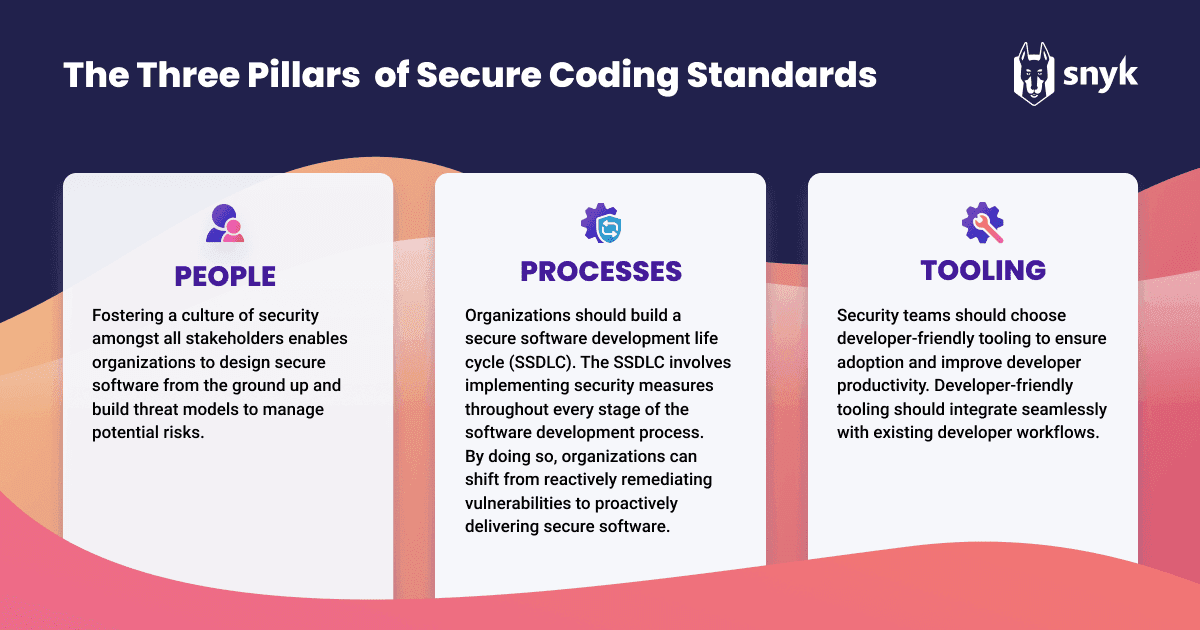The Three Pillars for Implementing Secure Coding Standards
How people, process and tooling can be used for secure coding standards
Delivering secure software at a rapid pace is crucial for most organizations today. While many developers prioritize faster development over security, there doesn’t need to be a trade-off. In fact, secure coding standards enable organizations to improve the security posture of their applications without impacting development velocity.
What are secure coding standards?
Secure coding standards are sets of rules and guidelines used by an organization to reduce security vulnerabilities and errors during development. The standards used will vary in different organizations due to different security requirements, such as PCI compliance requirements for applications that handle payments.
Along with coding principles, there are a number of standardized vulnerability databases like Common Vulnerabilities & Exposures (CVE), National Vulnerability Database (NVD), and the Snyk Intel Vulnerability Database that developers can use for vulnerability management.
Why Is Secure Coding Important?
Secure coding is crucial for delivering high-quality software without putting organizations at risk of a security incident. Insecure code, especially in industries that deal with sensitive data, could result in financial and reputational damage, market manipulation and theft, and other negative consequences. Secure coding from the start ensures applications are built with a solid security foundation to protect businesses and their stakeholders.
Let’s take a closer look at how secure coding standards can enable the delivery of secure software. We’ll also cover the three pillars for adopting secure coding standards, including some secure coding guidelines to consider.
The Need For Software Security Standards
While secure software is a priority for most organizations, there’s a cybersecurity skills gap that’s impacting development teams. In fact, only one of the top 24 undergraduate computer science programs in the U.S. includes a security course as a core requirement. Despite a chronic shortage of security talent, therefore, new developers entering the workforce are underprepared to implement secure coding practices.
When companies adopt secure coding standards — or formalized coding practices that prevent the introduction of vulnerabilities — developers will have the guidance they need to safely deliver higher-quality software. These secure coding standards (which we’ll cover later on) can dramatically improve the security posture of an application without becoming a barrier to development.
In addition, a recent study found that the average company fails to remediate 28% of the vulnerabilities in their hardware and software, leading to a backlog of over 57,000 unfixed security issues. Developers that write secure code could slow the flow of new issues being introduced into the codebase to combat the increasing vulnerabilities backlog many companies are facing.
The Three Pillars of Secure Coding Standards
Implementing secure coding standards requires a mindset shift by developers, adoption of new processes, and the right security tooling. Here’s a closer look at each of these.

People
The first key aspect to applying secure coding standards is fostering a culture of security amongst all stakeholders, from developers to IT operations staff and product managers. This enables the organizations to design secure software from the ground up and build threat models to manage potential risks.
A security champions program is also a great way to bring security knowledge to development teams. Security champions are developers who are interested in application security and work closely with the AppSec team, but remain a part of the development team. That means security champions can bridge the gap between security and development teams and accelerate the adoption of secure coding standards.
Processes
Along with fostering a culture of security, organizations should build a secure software development life cycle (SSDLC). The SSDLC involves implementing security measures throughout every stage of the software development process, from design through to development, testing, deployment, and maintenance. By addressing security issues at each phase of the project, organizations can shift from reactively remediating vulnerabilities to proactively delivering secure software using secure coding practices from the start.
While manual secure code reviews are useful for preventing security issues, it’s also effective to implement automated security scanning wherever possible. For example, SoftwareComposition Analysis (SCA) is a great way to leverage a vulnerability database to detect and remediate known security issues as soon as they’re published. When organizations automate their security processes, they can more easily stay ahead of the latest threats.
How do Teams Apply Secure Coding Standards?
When applying secure coding standards, it’s crucial to foster a strong security mindset with development teams, implement streamlined security measures into existing workflows, and choose the right security tools that developers will want to use. When secure coding standards are applied effectively, companies can shift towards a DevSecOps approach to software delivery. That means organizations can ensure that developers take responsibility for the security posture of an application without impacting development velocity.
Tooling
When implementing secure coding standards, it’s crucial that security teams don’t try to force new tools onto development teams. This can create friction and slow the rollout of new security tools and processes in the long run. Instead, security teams should choose developer-friendly tooling to ensure adoption and improve developer productivity.
More specifically, developer-friendly tooling should integrate seamlessly with existing developer workflows. Developers are far more likely to use security tools that won’t slow them down or add a lot of additional effort. A frictionless security tool experience will encourage developers to take more ownership of application security as well.
Get started in capture the flag
Learn how to solve capture the flag challenges by watching our virtual 101 workshop on demand.
Putting it all together
As you can see, a multi-layered approach is the best way to implement secure coding standards. Using Snyk’s Cloud Native Application Security (CNAS) Platform, organizations can empower developers to take ownership over application security and apply secure code standards to their development processes immediately. You can also try Snyk's free code checker tool for a quick check on the security of your code.